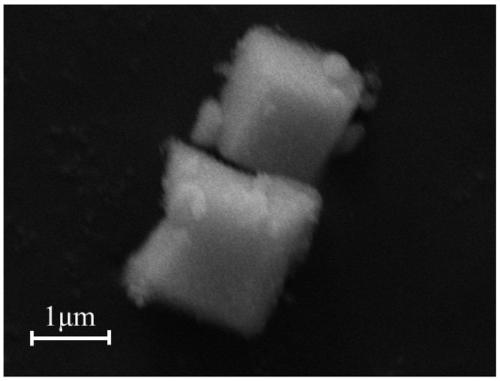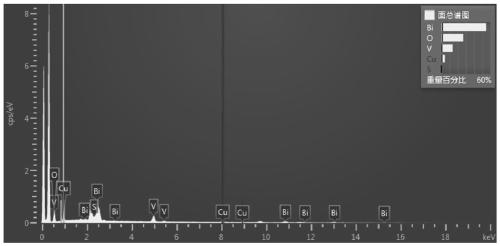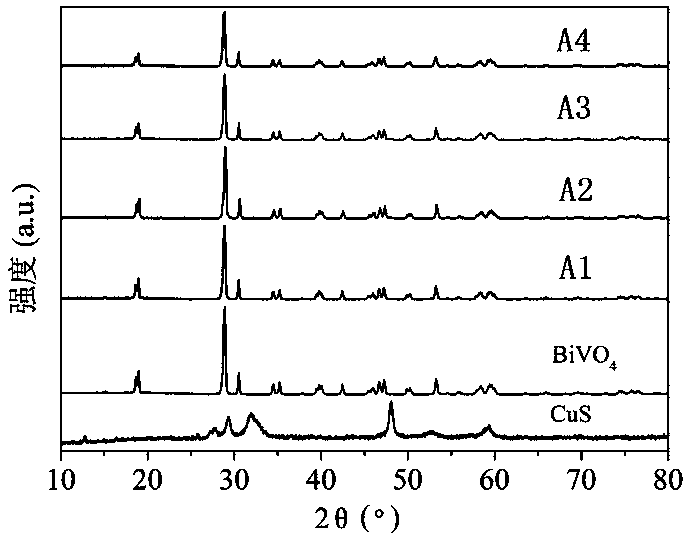Method for removing antibiotics from water body by using copper sulfide/bismuth vanadate heterojunction photocatalyst
A photocatalyst, bismuth vanadate technology, which is applied in physical/chemical process catalysts, chemical instruments and methods, natural water treatment, etc., can solve the problem of fast photogenerated electron-hole recombination rate, harsh conventional conditions, and strict temperature requirements, etc. problems, achieve good application value and application prospects, strong reusability, and high processing efficiency
- Summary
- Abstract
- Description
- Claims
- Application Information
AI Technical Summary
Problems solved by technology
Method used
Image
Examples
Embodiment 1
[0045] A kind of method utilizing copper sulfide / bismuth vanadate heterojunction photocatalyst to remove antibiotic in water body, antibiotic is ciprofloxacin, comprises the following steps:
[0046] Weigh bismuth vanadate (BiVO 4 ), copper sulfide (CuS) and copper sulfide / bismuth vanadate heterojunction photocatalysts (A1, A2, A3, A4), 100 mg each, were added to 100 mL, 10 mg / L ciprofloxacin solution (the The pH value of the solution is 5.6), magnetically stirred for 30 minutes under dark conditions, so that the adsorption-desorption equilibrium between ciprofloxacin and the photocatalyst was reached, and then the photocatalytic reaction was carried out under visible light with a wavelength of 400-760 nm for 90 minutes, The photocatalytic reaction was carried out at a magnetic stirring speed of 550 r / min to complete the removal of ciprofloxacin in water.
[0047] Blank group: take 100 mL, 10 mg / L ciprofloxacin solution without adding any photocatalyst, and treat it under the...
Embodiment 2
[0068] Investigate the degradation effect of copper sulfide / bismuth vanadate heterojunction photocatalyst on ciprofloxacin in the presence of different coexisting ions, including the following steps:
[0069] Weigh 5 parts of the copper sulfide / bismuth vanadate heterojunction photocatalyst (A3) prepared in Example 1, each 100 mg, and add to 100 mL, 10 mg / L ciprofloxacin solution (the pH of the solution is 5.6), add the coexisting ion Na to the 4 Rhodamine B solutions at the same time 3 PO 4 、Na 2 HPO 4 , NaH 2 PO 4 and CaCl 2 , and the other without adding any coexisting ions. Magnetic stirring was performed under dark conditions for 30 min to achieve an adsorption-desorption equilibrium between ciprofloxacin and copper sulfide / bismuth vanadate heterojunction photocatalyst, and then the photocatalytic reaction was carried out under visible light with a wavelength of 400–760 nm for 90 min, wherein the photocatalytic reaction was carried out at a magnetic stirring speed o...
PUM
| Property | Measurement | Unit |
|---|---|---|
| thickness | aaaaa | aaaaa |
Abstract
Description
Claims
Application Information
 Login to View More
Login to View More - R&D
- Intellectual Property
- Life Sciences
- Materials
- Tech Scout
- Unparalleled Data Quality
- Higher Quality Content
- 60% Fewer Hallucinations
Browse by: Latest US Patents, China's latest patents, Technical Efficacy Thesaurus, Application Domain, Technology Topic, Popular Technical Reports.
© 2025 PatSnap. All rights reserved.Legal|Privacy policy|Modern Slavery Act Transparency Statement|Sitemap|About US| Contact US: help@patsnap.com



